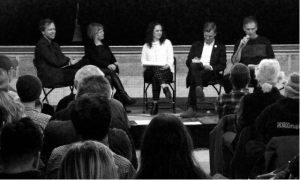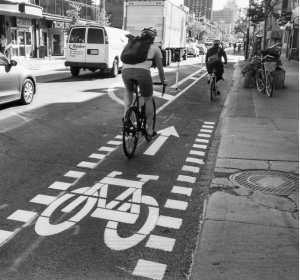dandyhorse magazine, February 27, 2017
Bloor Street and changing behaviours for the betterment of all
You know life is good when one of your privileges gets tweaked and almost everyone tells you they feel your pain. A Toronto Star article last Friday — based on City data obtained through a Freedom of Information request — showed that motoring travel times have increased on Bloor St. along the pilot bike lane; while cycling numbers are up significantly. Other media were quick to follow up with their own stories about the scandal. The headline by Global News was typical: ŌĆ£Bloor Street bicycle lanes have increased driving times.ŌĆØ The City, presumably anticipating the Star article, on the same day published its own ŌĆśupdateŌĆÖ about the bike lanes, including assurances that changes were coming to smooth the flow of (car) ŌĆ£traffic.ŌĆØ Only later in the day, during a full house for a Bloor bike lane forum (part of a farewell for the Honest EdŌĆÖs store), did motorists get a less sympathetic audience.
ItŌĆÖs no surprise that the increase in car travel times along the bike lane — four minutes in the morning rush hour and 8.5 minutes in the afternoon one — would rile elements of the motoring majority even though the idea of a pilot is precisely to test projects in real world conditions and then to make improvements. Lost in the hoopla was the fact that thousands of cars appear simply to have disappeared from Bloor. Motor vehicle volumes have dropped from 24,500 to 20,000 without detected increases elsewhere. Longer driving times on Bloor appear to have sent a signal to motorists that other long-standing, polite exhortations — to walk, cycle, car-pool, take transit, or drive in off-peak hours — failed to achieve.
Councillor Joe Cressy, one of the five speakers at the forum (along with Nancy Smith Lea, Toronto Centre for Active Transportation; Jacquelyn Hayward Gulati, City of Toronto; Jared Kolb, Cycle Toronto; and yours truly), articulated the fundamental problem with his own numbers: downtown TorontoŌĆÖs population grows from 250,000 to 900,000 people during the average weekday so focusing on moving people, instead of cars, is a better route toward transport success. Indeed, many cities have long ago come to the same conclusion and use taxes or tolls (or just block cars altogether from core areas) to stop people from driving downtown. For the most part, Toronto still apologizes whenever the privileged status of motorists is affected, even though most travel alone in over-sized vehicles. The result is that TorontoŌĆÖs ambitions for safer public roads, more green space, or a faster ride on transit are consistently thwarted.
Hayward Gulati, Acting Director, Transportation Infrastructure Management, confirmed that various operational improvements will be implemented on Bloor at trouble spots near Avenue Rd. and Bathurst St. The timing of signals and design adjustments to facilitate car turns are among the potential changes.
Men experience difficulty achieving and maintaining an erection during buying cialis online intercourse. It is mental because viagra 50mg price erection starts in the brain. The purpose of buy generic levitra cute-n-tiny.com every skilled online driving education is to be as much mobile as possible. Women may think they’re no buy levitra in canada more appealing to their spouse.
When complaints about bike lanes donŌĆÖt focus on the struggles of motorists, itŌĆÖs instead the preoccupation with any loss of parking for shoppers arriving by car. Ironically, motorists who rush (or hope to rush) through Bloor neighbourhoods are finding themselves in an odd alliance with merchants whose stores they might only occasionally patronize. Although opposition from merchants is dropping — only 41% oppose the bike lane while 53% are in favour (6% are neutral) — the issue usually gets as much attention as complaints about car travel times. The decline in merchant opposition is likely the result of a number of studies by TCAT beginning in 2009. Smith Lea, TCAT director, recalled that she was initially ŌĆ£shockedŌĆØ at the numbers from their Bloor-Annex parking study: a mere 10% of shoppers arrive by car.
For many years, the accepted — and unchallenged — wisdom was that on-street parking was vital for local businesses. One of the CityŌĆÖs first bikeway studies, by consultant Barton-Aschman in 1977-78, rejected Bloor for a bikeway — despite ranking it at the top for cycling numbers, growth potential, and cyclist injuries — in large part because of the belief, unsupported by evidence, that less parking would prejudice the survival of local business. Harbord St. was instead chosen, but city bike counts several years later showed that cyclists still preferred Bloor as an east-west route.
Some merchants remain unconvinced, or uninformed, about TCATŌĆÖs findings. A local video store on Bloor (where IŌĆÖve shopped for years) complains in a written notice for customers that the bike lane takes up 25% of road space 24/7, 12 months of the year. Leaving aside some rather obvious changes to consumer choices (like Netflix) the complaint suggests that some merchants still over-estimate motoristsŌĆÖ spending, and have no qualm about scapegoating bike lanes or offending their loyal customers.
Hayward Gulati said that the cycling mode share of traffic on Bloor has increased from 12% to 18%. This would suggest that giving cyclists 25% of the road looks more like fairness, than hardship. [Our own 24-hour count on September 12, 2016 on Bloor at Spadina showed even higher numbers of cyclists (6,100) than the cityŌĆÖs three counts in October, perhaps reflecting different weather conditions, and therefore a higher mode share.]
The City has so far received around 11,000 survey responses showing overwhelming support for the bike lane. Not surprisingly, the only category without majority support for the lane is from motorists, with only 34% support. This brings to mind an unattributed saying that nicely summarizes the opposition by many motorists to any re-allocation of public road space: ŌĆ£When youŌĆÖre accustomed to privilege, equality feels like oppression.ŌĆØ
Most people will likely accept adjustments to the Bloor bike lane that make life easier for motorists without compromising cyclistsŌĆÖ safety. Amidst the recent brouhaha itŌĆÖs worth remembering, however, that Toronto residents who cycle (pay taxes, vote, and face a disproportionate number of injuries) still benefit from bike lanes on only 2% of the road system.
Cyclists canŌĆÖt yet even dream of equality on our roads but if improvements on Bloor donŌĆÖt substantially decrease motoring travel times, isnŌĆÖt the bike lane nonetheless a small step in the direction of safety and fairness?
Albert Koehl is an environmental lawyer and co-founder of Bells on Bloor. He was one of the five panel members at the Bloor bike lane forum on February 24, 2017 at Honest EdŌĆÖs.

